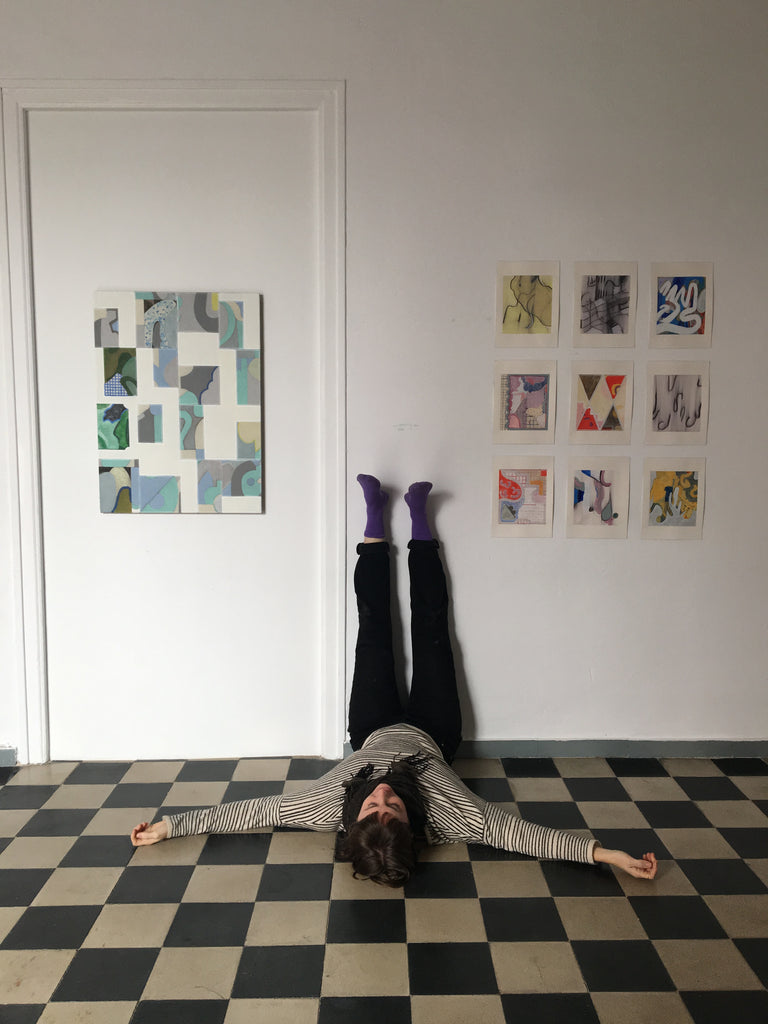No Products in the Cart


Debbi Kenote, b. 1991 is a New York based artist who received her MFA from Brooklyn College. She has shown her work throughout the U.S. including Page Bond Gallery, Peekskill Project, Deanna Evans Projects, and Front Room Gallery.
How do you describe your paintings?
There’s always the metaphor about paintings being a window: Are you inside? Are you outside this space? And it creates a little bit of “playful distortion” or disorientation. But there’s also a rhythm where the playfulness is on the outside and the inside.
Tell us about your creative style
I think what I’m really interested in is creating shapes. I’ve gone back and forth between painting and sculpture. I got my undergrad in painting and my masters in sculpture. Working in 3D, I learned to see shapes as floating — something you can move around. When I went back to painting I was really interested in creating emotion and feelings through shapes.

Where do you get inspirations for your titles?
My titles often pull from nature – or the natural world. I often name things during or after the painting, not before. Somewhere along the line, I’ll get inspired by something or it’ll remind me of something.
Pericarp (pictured below) is the title of this painting, which is the layers that go outside the ovary or the pit of a fruit. I was thinking about how soft that border was and the inside being more mysterious and organic-looking.

This one is called Great Horned (pictured below). I grew up in the Pacific Northwest, where there’s a lot of great horned owls. The painting is an abstraction of hands and eyes, and once I made it the eyes were big like an owl, reminding me of my childhood with owls.

The titles often have personal histories that I put into them. Nevertheless, they are things that you could relate to nature, like a shell, an animal, or a plant.
WORKS BY THE ARTIST
Although your works are abstract, some of them look like puzzles, in a way. What kinds of feelings do your art evoke?
When I’m making my paintings I don’t really think of them as puzzles, but I always enjoy that they end up looking like one. For some reason, I fell in love with the idea of the shapes meeting versus them hiding. I think that’s where the puzzle feeling comes from. To me, it’s more about blocking out shapes and creating contrast — which also is a way of sneakily pushing back against painting.
 |
 |
You are a big activist. What social issues are you passionate about and how is your art reflective of them?
Activism is a big part of my life. In 2020 I began to focus on mutual aid work and community food distribution, which is something I'm really passionate about. I'm part of an incredible bike organization called "Ride to DC," that brings together cyclists to celebrate Black lives and to diversify cycling. As far as my painting? I think as an artist, I can't help but make in the shadow of the world unfolding around me. I'm not sure that politics show up in my work, however, I do think that choosing to make art is in itself a political act. In any fascist regime, it's often the arts and the media that are first to be censored. My work is concerned with aesthetics and formal issues, and they don't translate allegorically. But I like to think I'm adding some beauty to the world during an especially heavy couple of years. Outside of my studio, I believe I have a responsibility to be informed, engage in thoughtful dialogue, and most importantly, listen.
“ Outside of my studio, I believe I have a responsibility to be informed, engage in thoughtful dialogue, and most importantly, listen.”
How did the Covid-19 pandemic affect your creative process?
I took probably three or four months off of the studio, only doing little sketches but not much else. When I came back, Pericarp was the first big painting I had finished. It's very colorful. It has some moods to it.

Do you have any advice for other young artists?
I encourage people to just keep making their art.






